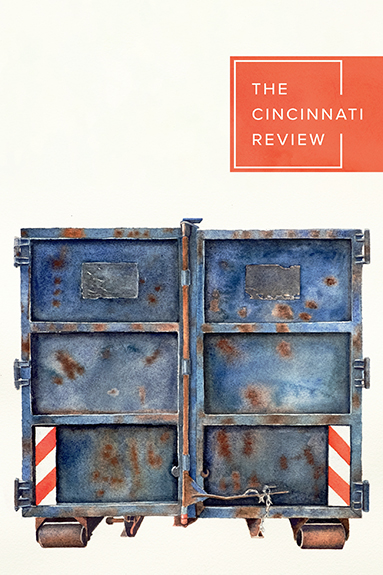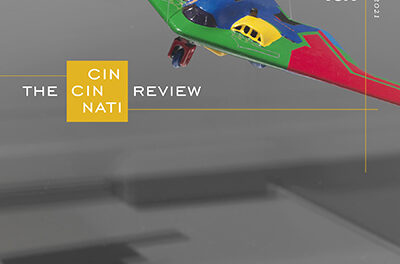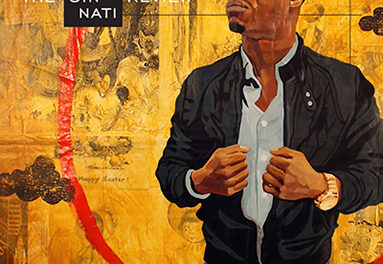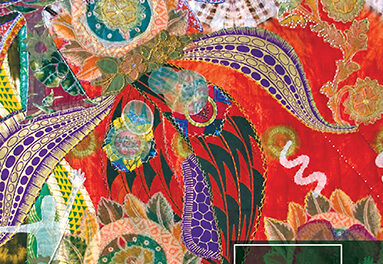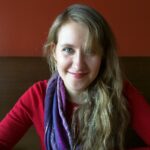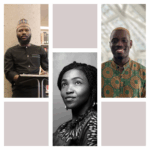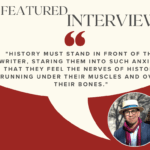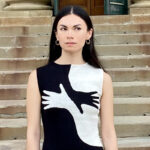The train curved around the mountains of West Virginia, and my father said to look out the window. He pointed to our right, and I saw the engine. Then he pointed to his left, and I saw the red caboose.
“We’re one big circle,” he said. “I don’t know if we’re coming or going. If we’re not careful, we’ll meet ourselves.”
He laughed, and I laughed too, not because I understood the joke but rather because his good humor was a rare commodity, and I held it close to me. Since he’d lost his hands after having them mangled in a corn picker when I was barely a year old, he’d been a man of temper. He’d filled our home with his anger. I can still recall the sound his prostheses made when he banged them together to get the right angle for grasping something, the curved pincers of those steel hands making a sharp clanging noise. Or the thump of them hitting the floor each night when my mother helped him slip his arms from his harness so she could hang his “hooks” over a straight-backed chair. He used one of those hooks to point out the window that day on the train. I was four years old, and we were on our way to Washington, DC, to see my aunt, my mother’s sister, who’d been diagnosed with lung cancer.
I’m not sure I knew about her illness at the time, 1960. I only knew we were on this train, the farthest I’d ever been from our farm in southeastern Illinois. My mother, as usual, was quiet. She tended to be a reserved woman, a woman of duty, the oldest of her five siblings. From an early age, she’d mothered her brothers and sisters, and now one of them was sick, and she was on her way to see what she could do to help.
This trip would be the last time she saw her sister because the next winter Aunt Gladys would be dead. My parents would leave me to the care of another aunt, my father’s sister, and they’d travel to Minneapolis where Aunt Gladys would be buried in Fort Snelling National Cemetery. Her husband, Duane, was a career military man who’d taken her far from her rural home in Illinois to Germany, where she was diagnosed, and then to Washington, DC, so she could get treatment at Walter Reed Army Medical Center, and finally to his native Minnesota to be laid to rest. My mother came home with a photograph of the white headstone on the snow-covered ground; a single red rose lay at the base.
“It looks cold,” I said.
“It was,” my mother said. Her voice was weary and sad. “It was very, very cold.”
* * *
Sometime before my wife’s mother, Roena, died, Cathy asked her to please tell her the identity of her biological father.
“I’m fifty years old,” Cathy said. “It’s time I knew.”
They were sitting on Roena’s screened-in back porch. It was summer, and I imagine the birdsong and the chatter of fox squirrels and the warm breeze moving through the branches of the giant oak that shaded the house.
“Does the name Louis P— mean anything to you?”
Cathy nodded. “He was the one you were with when you had your car accident.”
“That’s right.”
The car crash had broken a vertebra in Roena’s neck, and after months of pain, she’d let a surgeon replace it with a cow bone. She’d been in the hospital in St. Louis, a three-hour drive from her home near Bridgeport, Illinois.
“Him?” Cathy said.
I can see Roena taking a long drag off her cigarette and holding the smoke in her lungs before letting it out.
“Him,” she said. “He’s your father.”
* * *
My mother and father were older parents. My mother was forty-five when I was born; my father was forty-two. I wasn’t meant to come along. I was, as they used to say, an accident—a euphemism for a collision of two bodies, a collision that resulted in a birth. There was a time in my life when I wondered whether I might be adopted. My parents were so old. Or maybe I was a foundling, abandoned by my real parents and then taken in by this farmer and his grade-school-teacher wife. This man who lost his hands in a farming accident, and this woman who despite his anger loved him and was his faithful wife then and ever after.
“What am I to do now?” my mother asked when my father died and she saw him in his casket. It was one of the few times I ever saw her cry. She held a handkerchief to her mouth. “I’ve taken care of someone all my life.”
Even now, remembering how her shoulders heaved with her sobs as I put my arm around them and tried to comfort her, my throat aches with my own tears—my whole body aches—thinking of the lonely days and years that waited for her, those dark days of her widowhood.
* * *
I sent my first email to Cathy on April 5, 2008. We were married to other people and had been for some time, but since we’d dated for four months when I was eighteen and she was sixteen, I’d never forgotten her. In early spring, the time of year we first took note of each other, the old feelings would rise, and soon I’d be playing the songs of Jim Croce and the Carpenters and all the other music we used to listen to on the eight-track player in my Plymouth Duster. I used the Internet to locate her professional email address and saved it in a drawer in case I ever worked up the courage to use it.
Which I did that day in April. “Is this the Cathy Hensley I remember from Bridgeport? If so, would you like to reminisce?”
Thirty-four years had passed since the time of our first love. We’d gone our separate ways—her choice, not mine—and we’d had our separate marriages, each of which turned out to be unhappy. By 2008 my wife had hurt me, and I’d hurt her, and I felt myself surrounded by darkness. But no one should feel sorry for me. I’m the one who finally gave up on my marriage, and in the process, I hurt people who didn’t deserve to be hurt. I’ll know that forever.
Is this the Cathy Hensley . . . ?
She answered immediately. “Yes, it’s me. I’ll write more tomorrow.”
And like that, we began a life of secrets and deceits.
* * *
When I finally moved out of the home my wife and I shared, I left behind the lederhosen my Aunt Gladys had sent me from Bavaria when I was a small child. Somehow they’d survived the years, and from time to time I’d take them out and admire the leather shorts with their ornate stitching and H-shaped suspenders, and I’d think of this aunt I never really knew and how despite what she may have been going through—a woman in a foreign land who was, or would soon be, seriously ill—she took the time to send this gift to the only child, the accident, who’d come to her sister in the middle of her life.
I never understood why those lederhosen meant so much to me. I don’t remember wearing them—the leather was stiff and uncomfortable—but I do recall the zippered compartment hidden on the inside of the waistband where I could keep whatever I needed to hide.
* * *
One evening in 2011, Cathy received a message via Facebook: “I think you’re my sister.” Eventually, DNA results would confirm this. Jana and Cathy shared both a mother and a father.
“His name was Louis P—,” Cathy told her sister.
By this time, Roena was dead. Diagnosed with stage 4 lung cancer, she’d made the choice not to receive treatment. Three weeks later she was gone.
Before that, after learning Roena’s identity, Jana had called her once. When Jana told her who she was, Roena paused and then said, “There’s no one by the name of Roena here.” Then she hung up the phone.
Louis was a construction foreman from Springfield, Illinois, and he’d been in Lawrence County—Roena’s county—supervising the building of a new school. Who knows how the two of them met or how they came to be out for a drive in the country on a Sunday afternoon when the accident occurred. This happened in November 1962. The only reference to the event occurs in the April 19th edition of The Lawrenceville Daily Record the following year:
Miss Roena Carl is a patient in Missouri Baptist Hospital in St. Louis. She underwent surgery this week for a back injury she received last November when involved in an auto accident.
A search of the area newspapers from that month reveals nothing about the accident, a fact that mystifies me since car wrecks were, and still are, reported regularly in this part of the world. I don’t know the details of the accident. I only know it was severe enough to break that bone in Roena’s neck—that and the absence in the news of her being in a car with Louis that long-ago Sunday in November. Could it be he never called the police? Perhaps, driving too fast, he lost control of his car in the loose gravel of those country roads and ran into an electric pole. Maybe the car was drivable. Maybe he fled the scene because he didn’t want word to go public. After all, he was a married man, but the woman with him wasn’t his wife.
* * *
Cathy and I met in hotels around the country when one of us had to travel for business. I’m not proud of that fact. I wish after we’d reconnected we hadn’t had to sneak around under the guise of being “just friends,” but the truth is the truth, and there’s nothing I can do to change it. Once you agree to a life of secrecy, you become a different person than the one you’ve always been. I used to think I was a decent man. Then I watched myself turn into someone who would lie to cover his tracks, who would betray the woman he promised to love forever (never mind the fact that she’d betrayed me more than once over the years we were together), who would become a middle-aged cliché, all for the sake of a second chance at happiness.
One time I met Cathy in Schaumburg, a northwestern suburb of Chicago. She was there for her job, and I manufactured an excuse for my trip to the Windy City. Recently, an email had arrived from a woman named Nancy, a woman I didn’t know: “Your aunt was my mother.” Nancy went on to explain that her own daughter had gone on a search that found my Aunt Gladys, who’d given up a child to adoption via a home for unwed mothers in Omaha, Nebraska. Nancy told me she wanted only to confirm some information. “I had a happy childhood,” she said. Her daughter wanted to know her mother’s biological parents for their medical history, and somehow a search for the name “Read” had turned up my first memoir. The book-jacket bio told Nancy’s daughter where I taught, and from there she was able to find my email address.
Nancy had the information the unwed mothers’ home had given her about my grandparents and Gladys’s siblings. Everything matched up, down to the fact that the oldest sister, my mother, had been single and a schoolteacher living at home with her parents at the time of Gladys’s pregnancy. Still, for whatever reason, I was dubious. Maybe I didn’t want to believe my family had a scandal because I was in the midst of one of my own making. I’d barely known Gladys, so I wasn’t worried about being disillusioned if this woman’s claim turned out to be true. I was thinking more of my mother, the big sister, and whether she knew Gladys’s story. It’s possible she didn’t. As a young woman, Gladys had left her home in southeastern Illinois and gone to La Grange, a western suburb of Chicago, to work as a maid and nanny for a wealthy family. But the information from the unwed mothers’ home claimed Nancy’s mother had worked at a Walgreen Drugs in La Grange, that she was engaged to be married and intended to go ahead with that marriage after the birth and her return home.
I told my wife I was going to Chicago to see what I could find out about Gladys—where she’d lived, where she’d worked, the man she’d married. All of that was true, but my real reason for going was to be with Cathy.
Before I left, I called my Uncle Harry, my mother’s lone surviving sibling. I didn’t want to directly tell him the news I’d received in case it was a family secret he didn’t know. I took a more roundabout approach. “I never knew Aunt Gladys very well,” I said. “I know she worked as a maid in La Grange. What else can you tell me?”
“When she first went to La Grange,” he said, “she worked at a Walgreens.”
With that fact confirmed, I felt brave enough to tell him about Nancy’s email and her claim that Aunt Gladys was her mother.
“Did you know?” I asked Harry.
He didn’t hesitate. “No, I had no idea.”
* * *
In the few photographs I have of Gladys, she looks like someone I would have enjoyed knowing. In one of them, she sits on an upholstered armchair in my grandmother’s house and holds me—I’m barely a toddler—so that I’m upright on her lap, and she’s smiling at me. She’s wearing a navy-blue suit with a sky-blue shell under the jacket. The jacket is unbuttoned, and she looks completely comfortable with me. One hand is on my chest, steadying me; the other hand supports my bottom. I’m wearing a red romper, and the color complements her red fingernails and her lipstick. Her fingers are long, and her nails are nicely manicured. Anyone looking at that photograph, if they didn’t know, would assume we were mother and son.
What was it like for her to hold me after having given up a child of her own, the only child she would ever have?
* * *
Cathy remembers a stone bench, a rabbit, the green grass. “I was sitting on the bench with my great-aunt, Tom, and we were watching the rabbit nibble at the blades of grass.”
Her grandparents had taken her mother into a building, someplace Cathy couldn’t go. Her mother had a suitcase, and when Cathy’s grandparents eventually came out of the building, they were alone.
Cathy said goodbye to the rabbit. She held Tom’s hand and walked through the green grass. They got in the car and went home.
“Somehow I knew,” she says now, “we’d left a baby behind.”
* * *
Spit in a tube, send it away, and wait to learn your ancestry. That’s how Cathy and Jana used DNA to confirm they shared a mother and a father.
But what if there were other siblings out there who hadn’t done the saliva test for Ancestry.com? Cathy had heard of people who’d also used the registry at 23andMe, so she decided to do a test there just in case a match might appear.
Which it did. Two young women in North Carolina came up as possible half nieces. Their names were unfamiliar, but Cathy and I did what everyone does these days when they want to check someone out; we went to social media. I looked at the Facebook page of one of the women, and her father was someone I recognized. He was a Black man from Lawrenceville.
“We may not know these women,” I said to Cathy, “but we know their father.” I showed Cathy the Facebook page. “Looks like he’s your half brother.”
“But Mother told me . . .” She cut herself off mid-sentence, the truth appearing to her in a flash, an explosion that could take away sight, hearing, the ability to speak. Then she said, “Ohhhh,” drawing out the word, accepting what she now knew. “She lied to me,” she said.
Before Cathy and I married, we carried on an eight-year affair. I lied to my wife about where I was going and why, with whom I’d been on the phone, why she sometimes couldn’t reach me when I was away. I became practiced at deceit. Our marriage had been troubled for a good while, and I told myself my lies were justified, when the truth is they were small acts of cowardice. Lacking the courage to leave, to divorce, I persisted in lying to myself. I continued to believe I was a good man.
“You are a good man,” Cathy told me. She held faith that one day I’d divorce my wife, and then she and I would have a glorious life together.
It’s here where the story of my Aunt Gladys and that of Cathy’s mother, Roena, becomes my story as well. We were all experts when it came to leading our secret lives.
* * *
Imagine this 1950s-era small town in the Midwest. Lawrenceville had a slim number of Black citizens, but I don’t remember ever seeing an interracial couple while I was growing up. My first wife remembered being a teenager in the early 1970s when a Black boy asked her out on a date.
“Absolutely not,” her mother said.
My first wife wanted to know why.
“It’s all right to be friends with one,” her mother said, “but that’s as far as it goes.”
The message was clear when it came to the idea of romance between the races.
Cathy recalls a Saturday night around the same time when she and a group of friends were gathered in parked cars around the courthouse square. She heard a Charlie Rich song playing on an eight-track, and she followed that music until she found a car with a Black boy behind the wheel.
“I love Charlie Rich,” she said.
“Get in,” he told her. “We’ll go for a ride.”
When she got home, her mother asked her what she’d done that night. “I went for a ride with Joe Morris,” she said.
“Joe Morris?” her mother said. “That Black boy?” She pointed a finger at Cathy. “Don’t you ever do that again, missy. You stay away from that boy.”
At the time Cathy couldn’t understand her mother’s vehement reaction, but that was because she didn’t know what she didn’t know.
* * *
There was a time, Cathy tells me, when her mother lived in an apartment over a garage on Fifth Street in Lawrenceville. A man lived across the alley with his wife and children. His name was Raymond, but everyone called him Bud.
“I didn’t know him,” Cathy says now, “because for the most part I was living with my grandparents.”
Bud was an auto-body man who drove stock cars. Cathy remembers her mother taking her to the White Squirrel Speedway near Olney on Saturday nights to watch the cars go round and round.
“I always wondered why she liked the races so much,” Cathy said.
* * *
When Cathy did her first DNA test, the results came back with 16 percent African in her heritage. She didn’t know what to make of that until all the pieces started to come together.
“My father was Black,” she said. “What do you think about that?”
“I think you’re Cathy,” I told her. “I think you’re the woman I love.”
When Cathy shared the news of their father with her sister, Jana said, “It changes nothing, but it changes everything.”
I knew immediately what she meant. She and Cathy had grown up thinking they knew exactly who they were—Jana, a Jewish girl from Skokie, Illinois, and Cathy, a white girl who thought she was an only child. What must it have been like for them to discover this other aspect of their identity, one people had conspired to keep from them? What must it have been like for my cousin to find out her mother was my Aunt Gladys? What had it been like for my father, by all accounts a happy-go-lucky sort before his accident, to meet the angry man he became on the other side? Even I, who despite my childish imaginings eventually had no doubt about my parentage, stepped from one life to another where I met a part of me—the liar and fraud—I’d never known existed. How much can we stand to know about ourselves? What shapes lurk in the shadows just waiting for us to slip inside them?
* * *
For a time, when my Uncle Harry was a young man, he worked in a factory and lived with his sister Gladys and her first husband in La Grange. One day Harry suffered a serious accident at the factory that left him with a badly injured leg. Aunt Gladys nursed him. This would’ve been after she had her baby in Omaha and came back to La Grange to marry the father. That’s the detail that leaves me with questions I can’t answer. Why, if Gladys knew she was going to marry this man, did she give up the baby? Was it because there would have been no way to hide the fact that she’d conceived out of wedlock? Or was there some reason the father didn’t want the child? My older cousin Bill told me Gladys and her boyfriend used to drive down from La Grange so she could visit her family. The boyfriend’s name, Bill recalled, was a different name than that of the man Gladys married. Is it possible that man was the child’s father? I have no way of knowing. I can only speculate. Could it be there was something inside Gladys that kept her from wanting to be a mother? Could the decision have been hers and hers alone? Is it possible she consulted with my mother, her big sister? Could my mother have agreed with her? Could she have told Gladys, “Yes, yes. This is what you should do.”
The baby Gladys gave up in 1943 is now eighty years old. I know this because after Nancy sent me that first email explaining that she was my cousin, we’ve carried on a correspondence, meeting one time at her home in Michigan. She’s a jolly woman with a good sense of humor. I see my aunt Anna in her, and even my mother, who, despite how measured she could be, enjoyed a good laugh.
“My adoptive parents were wonderful,” Nancy wrote to me. “I’ve had a good life.”
“I wonder how much my mother knew,” I said.
Nancy’s reply? “Sisters talk.”
* * *
Cathy’s mother didn’t have a sister. She only had a younger brother, and he died in an accident in 1956. He was a student at Eastern Illinois University and had a summer job with Ohio Oil. One afternoon, he was helping to lay pipe at a lease. He was holding a long pipe on end, unaware that it was dangerously close to an overhead electric wire. The current jumped the gap between the wire and the pipe, traveled down its length, tore through the palm of his hand, and exited his body through his big toe. He died immediately. This golden boy. This star athlete. This straight-A student. Cathy has his high school letterman jacket, passed down from her grandparents to her mother and now to her. The jacket is wrapped in tissue paper and kept in a box. Cathy takes it out from time to time and rubs her hand over the blue felt, the raised edges of the “B” for Bridgeport, the white leather sleeves. I see him in this jacket. It stretches across his broad shoulders. He has his madras shirt tucked into his chinos. His flattop haircut is stiff with Lucky Tiger Cru-Butch Hair Wax, and he’s splashed on some Aqua Velva aftershave. He’s shined his penny loafers and tucked dimes into the bands because he believes in the future. He dreams big. Cathy never knew her uncle—he died the year before she was born—but the tragedy of his passing hovered over all her family, particularly her mother, who was an average student, unremarkable in every way except for the secrets she carried to her grave.
* * *
Imagine Roena and Bud, a white woman and a Black man—a married Black man at that—in this itty-bitty town where they had to keep whatever it was they felt for each other on the down-low. Did Bud sneak across the alley to Roena’s garage apartment? Did anyone know what was going on between them? I think now of all the people who saw me with Cathy—my “friend”—in those days when I was married to someone else. Did we really think we were fooling anyone? How many people, when the truth finally came out, slapped their foreheads and said, “Of course.”
Roena had three daughters with Bud. Eventually, again thanks to DNA, a third sister, the one Roena was carrying the day of the stone bench and the rabbit and the green grass, would find Cathy. No matter how hard Roena tried to keep her secret, DNA has now revealed it all. What it doesn’t reveal are the yearnings and aches of her heart. Surely, she must have loved Bud, loved a man she couldn’t have, not fully, because he was married, and he was Black, and they lived in a place at a time when both would have been a scandal, and that would have been a burden too great for her to carry. Trust me. I know the guilt and shame of forbidden love, its onus only outweighed by the overwhelming desire to be with someone you’re not supposed to ever have. Roena must have loved Bud enough to have three daughters with him, their births spanning five years. She must have hoped and hoped and hoped that someday he’d be hers. Maybe then the two of them would leave that small town and go where they could live a life out in the open, their love on display for everyone to see. Somewhere along the line, though, hope ran out. Bud’s wife, weary of his womanizing, eventually divorced him, but before that happened, Roena must have cut ties. She went on to marry someone else, a kind man with whom she had a happy life. I wonder, though, whether she ever stopped loving Bud, the father of her three girls, just like I wonder whether Gladys ever forgot the baby she gave up in Omaha. I think of my father and the pain of his phantom hands after their amputation, that pain that told him they were still there, but when he looked, he saw only the scars of his sutured stumps. Will I ever stop loving the part of me I left behind when I divorced my wife, that part that was blameless and good, the part I’m not sure I’ll ever be able to reclaim?
When my father found out my mother was pregnant, he asked the doctor if he could “get rid of it.”
My mother, telling me this story after my father was dead, said he was concerned about her advanced age and just looking out for her. Maybe that’s true, but still, there you have it, an instant in which I might have never existed. Would my mother have mourned my leaving? Surely she would have carried my absence the rest of her life.
So, she went to Washington to see my Aunt Gladys for what would be the last time. She couldn’t save her. The cancer had its way just as it would with Roena. I wasn’t there when Roena died because I was still with my first wife, still holding on to the idea that I could be a decent man. But the heart wants what it wants, and I eventually stepped from my old life, one of darkness, to a new one full of love and light. I wish I’d done it differently. I wish I hadn’t hurt people along the way—my wife, Cathy, her husband, and even myself. Looking back on it all now, I know I could have easily ended up like Bud, who must have felt the absence of Roena and their three daughters the rest of his life. I didn’t want to be like my Aunt Gladys, who must have seen her own child in nieces and nephews like me, and I didn’t want to be like my father, who wished he could go back to the moment just before he put his hands in his picker’s shucking box and the rollers drew them in, that last moment when he was whole. I didn’t want a life filled with regret. So I jumped. I leaped from my nearly forty-year marriage, leaving behind my wife and a certain notion of myself—the good man, the kind man, the faithful husband.
Cathy says that just before Roena died, in those last minutes, she sat up in bed, looked off into the distance, as if she were seeing someone, and she began to giggle with delight.
“It was as if she were becoming a girl again,” Cathy said. “Her skin glowed. She radiated joy. Then she began to wave.”
We’re left to wonder whom she saw. Might it have been Bud, who’d been dead many years? Had he come to say he was waiting for her? Had she told him she’d be there just as soon as she could?
All we know for sure is that when she finally took her last breath, a streak of light moved from her body to a far corner of the room, slanting up to the ceiling before disappearing. Cathy saw it. Her daughter saw it. Her sister saw it.
And me? I hold faith in the possibility, desperate as I am to believe that at the end we burn with ferocious joy, that we’re always returning, bending toward the past, our ends doorways to our beginnings, our arms reaching out to all who loved us—everyone who ever loved us—even those we chose to let go.
Lee Martin is the author of The Bright Forever (Shaye Areheart Books/Crown Publishing, 2005), a finalist for the 2006 Pulitzer Prize in Fiction. His latest novel is The Evening Shades (Melville House, 2025). He teaches in the MFA Program at The Ohio State University.
For more great literary nonfiction in Issue 22.1, order now in our online store. Digital copies are only $5.

